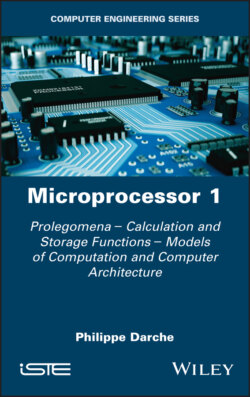Читать книгу Microprocessor 1 - Philippe Darche - Страница 3
List of Illustrations
Оглавление1 Chapter 1Figure 1.1. Ishango’s incised bones (source: unknown). For a color version of th...Figure 1.2. A quipu (source: unknown). For a color version of this figure, see w...Figure 1.3. Roman abacus (a) between the 2nd and 5th Centuries (© Inria/AMISA/Ph...Figure 1.4. An example of a Pascaline at the Musée des Arts et Métiers (source: ...Figure 1.5. Replica of the first Babbage difference machine3. For a color versio...Figure 1.6. Babbage’s analytical machine (© Science Museum/Science & Society Pic...Figure 1.7. One of the plans for Babbage’s analytical machine (© Science Museum/...Figure 1.8. Falcon’s loom. For a color version of this figure, see www.iste.co.u...Figure 1.9. Statistical machine (Hollerith 1887)Figure 1.10. Evolution of concepts and technologies in the development of calcul...Figure 1.11. A modern electromechanical relay, its equivalent electrical diagram...Figure 1.12. An RCA 5965 type electronic tube and an IBM 701 electronic board (s...Figure 1.13. A transistor and an electronic transistor board with seven inverter...Figure 1.14. One of the 15 DIP integrated circuit CPU boards from a DEC PDP-11/2...Figure 1.15. Evolution of computing performance over time (from (Bell 2008b))Figure 1.16. PC motherboard (5150) from IBM (1981). For a color version of this ...Figure 1.17. Axes of evolution over time of the price of classes (from (Bell 200...Figure 1.18. The iconic Cray-1 supercomputer referred to as the “World’s most ex...Figure 1.19. Evolution over time of supercomputer performance (according to Succ...Figure 1.20. IBM System/360 mainframe computerFigure 1.21. The IBM Application System (AS/400) family of minicomputersFigure 1.22. Evolution over time of the prices of minicomputers (in thousands of...Figure 1.23. An Octane graphics workstation from Silicon Graphics, Inc. (SGI). F...Figure 1.24. The first microcomputers: the Micral N from R2E and the ALTAIR 8800...Figure 1.25. Increasingly blurry boundaries. For a color version of this figure,...Figure 1.26. Categories of computers (according to Bell (2008a))Figure 1.27. The client–server model. For a color version of this figure, see ww...Figure 1.28. A blade server. For a color version of this figure, see www.iste.co...Figure 1.29. Example of a Beowulf server architecture. For a color version of th...Figure 1.30. The Antikythera mechanism (left) and a reconstruction (right), by M...Figure 1.31. The PACE 231R-V analog computer system from EAI (EAI 1964)Figure 1.32. Layered view of software infrastructureFigure 1.33. Historical timeline of the evolution of concepts for the families o...Figure 1.34. Need for computing for multimedia applications (based on 2003 ITRS ...Figure 1.35. Evolution of computer roles (from Nelson and Bell (1986))Figure 1.36. Evolution over time of the number of transistors of an integrated c...Figure 1.37. The fineness of etching of integrated circuits over the years (tech...Figure 1.38. The energy wall (from Xanthopoulos 2009 on data from ISSCC). For a ...Figure 1.39. Chip area achievable with progress in integration (according to (Ma...
2 Chapter 2Figure 2.1. Vocabulary for binary formatsFigure 2.2. Memory access policiesFigure 2.3. Memory organization and addressingFigure 2.4. Memory areaFigure 2.5. Memory hierarchyFigure 2.6. Types of storage technologies in modern computersFigure 2.7. Simplified classification of random access semiconductor memoryFigure 2.8. Detailed classification of permanent semiconductor memory
3 Chapter 3Figure 3.1. Description of the computation of a factorial via dataflow graphFigure 3.2. Positioning of the computation model in relation to the architectureFigure 3.3. Multi-level architectural conceptsFigure 3.4. Computer design layers based on Blaauw and Brooks (1996)Figure 3.5. Y-diagram (Gajski and Kuhn 1983)Figure 3.6. Hierarchical structure of a computerFigure 3.7. Different levels of abstraction of computer architecture based on Si...Figure 3.8. Abstract and concrete hierarchical aspects of an architectureFigure 3.9. The concept of computer architecture according to Sima et al. (1997)Figure 3.10. Layered design of a computerFigure 3.11. Positioning of architecture for four historic architectures (Corpor...Figure 3.12. Architecture according to von Neumann (1945)Figure 3.13. Von Neumann machine with its five functional unitsFigure 3.14. Simplified functional organization of the IAS machineFigure 3.15. Functional organization of a von Neumann machineFigure 3.16. Functional organization of the IBM 701 (based on Frizzell (1953), m...Figure 3.17. Infinite two-phase execution cycleFigure 3.18. Modern view of a von Neumann computerFigure 3.19. The three communications busesFigure 3.20. The three functional units of a microprocessorFigure 3.21. Internal circulation of information inside a microprocessorFigure 3.22. Microarchitecture of bus-based microprocessorsFigure 3.23. Decoding of an instruction by a hardwired sequencerFigure 3.24. Basic steps of the basic execution cycleFigure 3.25. Execution cycle flowchartFigure 3.26. Functional steps to execute an instructionFigure 3.27. Execution cycle described with different forms of accessFigure 3.28. Information flow in a processorFigure 3.29. Internal organization of a bus (control signals not shown)Figure 3.30. Functional internal organization of Intel 8080A microprocessors wit...Figure 3.31. Two variations of a double internal bus organization (CU and contro...Figure 3.32. Internal functional organization of the Motorola MC6800 microproces...Figure 3.33. Functional internal organization of the PACE microprocessor from NS...Figure 3.34. Internal three-bus organization (CU and control signals not shown)Figure 3.35. Pure Harvard architectureFigure 3.36. Example of a modified Harvard architecture (x86 family)Figure 3.37. Simplified architecture of a SPARC® family processorFigure 3.38. The four basic approaches to ILPFigure 3.39. Simplified classification of TLP architecturesFigure 3.40. Variation of characteristics over time (based on (Leavitt 2012))Figure 3.41. Microphotograph of an Intel Sandy Bridge quad-core i7 (source: Inte...Figure 3.42. Classes of instruction set architectures with examplesFigure 3.43. Zero-address stack architecture (from Nurmi (2007), modified)Figure 3.44. One-address architecture, with accumulator (from (Nurmi 2007), modi...Figure 3.45. Architecture with two (a) and three (b) register references (from N...Figure 3.46. Memory-register architectures (from Nurmi (2007), modifiedFigure 3.47. Three-address architecture (from Nurmi (2007), modified
